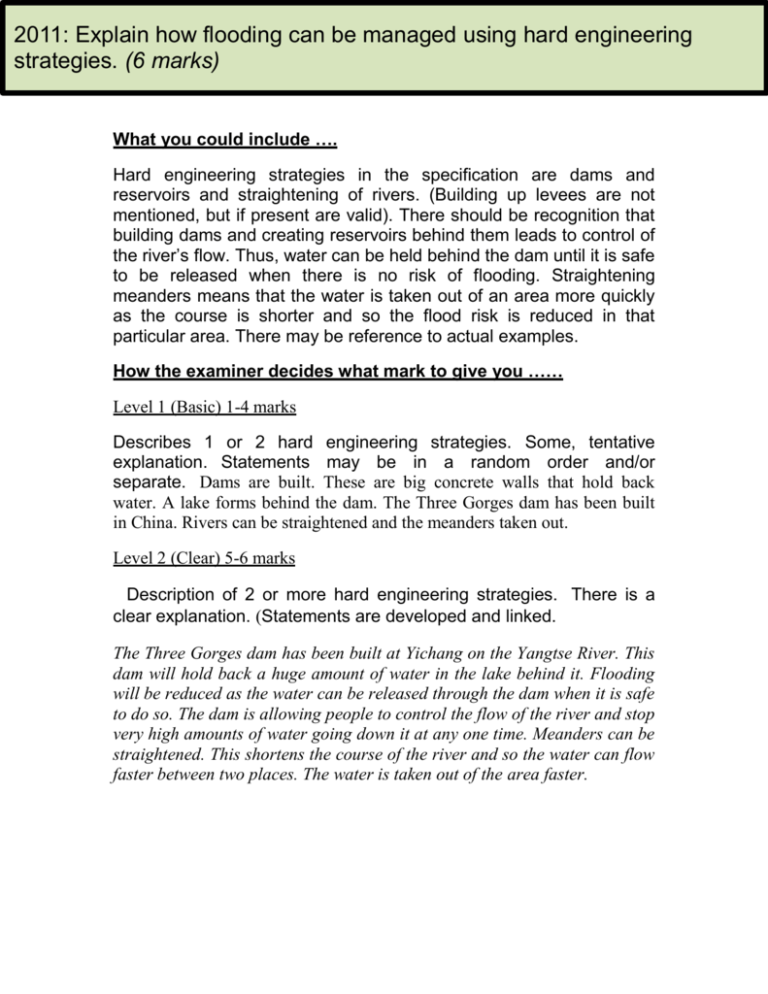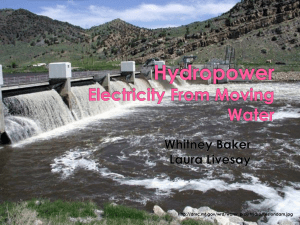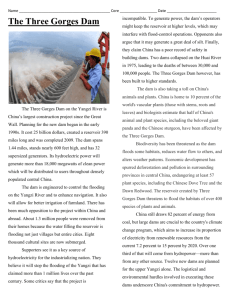mark schemes 2011 engineering qs
advertisement

2011: Explain how flooding can be managed using hard engineering strategies. (6 marks) What you could include …. Hard engineering strategies in the specification are dams and reservoirs and straightening of rivers. (Building up levees are not mentioned, but if present are valid). There should be recognition that building dams and creating reservoirs behind them leads to control of the river’s flow. Thus, water can be held behind the dam until it is safe to be released when there is no risk of flooding. Straightening meanders means that the water is taken out of an area more quickly as the course is shorter and so the flood risk is reduced in that particular area. There may be reference to actual examples. How the examiner decides what mark to give you …… Level 1 (Basic) 1-4 marks Describes 1 or 2 hard engineering strategies. Some, tentative explanation. Statements may be in a random order and/or separate. Dams are built. These are big concrete walls that hold back water. A lake forms behind the dam. The Three Gorges dam has been built in China. Rivers can be straightened and the meanders taken out. Level 2 (Clear) 5-6 marks Description of 2 or more hard engineering strategies. There is a clear explanation. Statements are developed and linked. The Three Gorges dam has been built at Yichang on the Yangtse River. This dam will hold back a huge amount of water in the lake behind it. Flooding will be reduced as the water can be released through the dam when it is safe to do so. The dam is allowing people to control the flow of the river and stop very high amounts of water going down it at any one time. Meanders can be straightened. This shortens the course of the river and so the water can flow faster between two places. The water is taken out of the area faster. 2011: Hard and soft engineering strategies are used to manage flooding. Choose either hard engineering or soft engineering and explain why it is the better strategy. (8 marks) What you could include …. Actual content will depend on strategies selected. Can refer to advantages of selected strategy or disadvantages of one that is rejected. For example if hard engineering is selected, likely to note the effectiveness of dams holding back water to control flooding. (Three Gorges Dam has reduced risk from 1 in 10 years to 1 in 100 years), may refer to the fact that many dams and reservoirs are multipurpose projects and so there are other advantages such as HEP (hydro electric power) and water supply. This approach means that something is being done to control flooding and that people’s lives and their property should be safe. It means that people do not have to live in fear of flooding or face the consequences of cleaning up or losing family and friends. It is more immediate than strategies like planting trees that take a long time to grow. Warning systems may save people’s lives, but their property is damaged and their possessions and so this is not good way of managing floods. They will be able to prepare but will suffer much more than if a dam had been built. How the examiner decides what mark to give you …… Level 1 Basic (1-4 marks) Describes 1 or 2 strategies. Simple statements, may be in a random order. Certain things are built in certain places. Next to the river, there are playing fields and car parks, housing is further away. In some areas, building is not allowed. Trees are planted to slow down to flow of water. Level 2 Clear (5-6 marks) Begins to consider why the strategy selected is better option. Advantages of option clear and/or disadvantages of alternative are included. Statements are developed and linked. Land use zoning means that land next to the river may be used as farmland or recreational use, but buildings are not allowed. This reduces the impact of flooding. It costs nothing and does not have any negative impact on the environment – the river floods in a natural way. Planting trees slows down the speed of the water and reduces flooding. It can improve the environment, but works with the natural environment. Level 3 Detailed (7-8 marks) Clearly focused on why the strategy selected is better option. Advantages of option clear and/or disadvantages of alternative in a discussion. Statements are developed and linked. Land use zoning means that land next to the river may be used as farmland or recreational use, but buildings are not allowed. This reduces the impact of flooding. It costs little, just the need to plan and does not have any negative impact on the environment – the river floods in a natural way. This is a much cheaper option than building up banks and creating dams and reservoirs, which have a bad effect on the environment. They interfere with the rivers natural processes, causing erosion after a dam. Over time, the lake behind the dam will silt up as the water is not flowing as it would in the river. Planting trees slows down the speed of the water and reduces flooding. This tries to help slow down the water cycle in a natural way, rather than controlling a river with a dam which is also very expensive. It works with the natural environment. Warning people of floods is useful as they can prepare, taking their possessions to higher floors – floods can still happen with dams and people may not be prepared if they are not warned.







